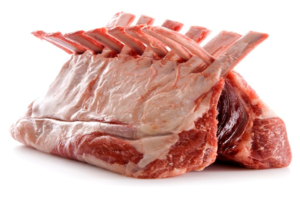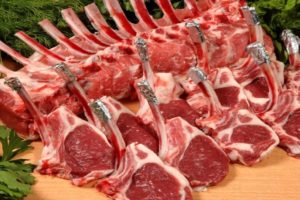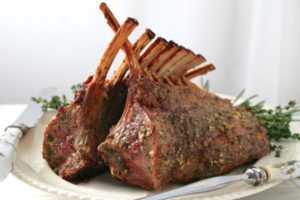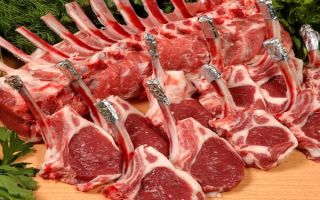Content
- 1 The chemical composition of lamb
- 2 Nutritional value and calorie content of lamb
- 3 Useful and medicinal properties of lamb
- 4 At what age can lamb be given to a child
- 5 Lamb consumption norms
- 6 Features of the use of lamb for some diseases
- 7 The benefits of lamb for weight loss
- 8 The benefits and harms of lamb broth
- 9 How to cook lamb properly
- 10 The harm of lamb meat and contraindications to use
- 11 How to choose and store lamb
- 12 Conclusion
Lamb was previously considered a spring staple and could only be cooked at this time of year. But now, in 2018, the product is on the shelves of almost every store all year round, and the benefits and harms of lamb are familiar to many. But for whom meat is useful and how to cook it correctly, you should figure it out before buying.
The chemical composition of lamb
Lamb contains one and a half times less fat than pork tenderloin. This feature makes it possible to consume this healthy meat for people who are overweight.

Due to its low fat content, lamb also has low cholesterol levels. The product contains a high content of B vitamins, tocopherol, vitamin D and K.
There are also many minerals in lamb, magnesium, calcium, zinc, sodium and others are found in large quantities.
Nutritional value and calorie content of lamb
The amount of BJU and calories per 100 g of the product are shown in the table All figures are indicated depending on the type of product processing.
|
|
Proteins, g |
Fat, g |
Carbohydrates, g |
Calories, kcal |
|
For a couple |
21,7 |
7,2 |
0,8 |
156,0 |
|
Stew |
18,8 |
18,3 |
0,6 |
240,2 |
|
Boiled |
23,0 |
20,0 |
1,4 |
272,7 |
|
In the oven |
16,3 |
15,3 |
0,4 |
203,0 |
|
Fried |
20,3 |
22,8 |
1,1 |
301,4 |
Useful and medicinal properties of lamb

The benefits of lamb for the human body are quite extensive. The balanced content of macro- and microelements in meat makes this product a healthy delicacy.
Due to its low calorie content, meat is recommended for people suffering from excess weight. It is regularly included in the diet of many losing weight girls.
Since there is little fat, cholesterol is also present in small quantities, while tocopherol, vitamin D and K are present in large quantities. This means that meat is good for patients who suffer from atherosclerosis and diseases of the cardiovascular system.
The presence of B vitamins has a positive effect on the functioning of the digestive system. They accelerate metabolism, tone up and take part in the synthesis of nutrients.
Folic acid (vitamin B9) helps to strengthen the immune system.
Other benefits and useful properties include:
- Normalization of the nervous system due to the content of B vitamins.
- Reduces the symptoms of colds.
- Prevents the formation of caries due to the content of fluoride and calcium in large quantities.
- Increases hemoglobin levels due to iron content.
The benefits of lamb for men
Lamb has a positive effect on the male body. The zinc content in meat contributes to the formation of testosterone and increases potency.
Why is lamb useful for women
For women, this product is useful primarily because of its low calorie content. You can eat meat and not worry about being overweight. In addition, lamb promotes a speedy metabolism.
Is it possible to eat lamb for pregnant and lactating
Lamb is rich in folic acid (vitamin B9). This element has a positive effect on the development of the fetus in accordance with the term, and also forms nerve cells. Therefore, ram meat is recommended for a lady during pregnancy.
Mothers who are breastfeeding their baby should be careful about including lamb in their own diet. Despite all the positive properties, meat can be dangerous for the baby. These are mainly colic, stool disturbance and bloating. Therefore, you should take a responsible approach to the use of lamb when breastfeeding.
If an allergic reaction is not observed in the baby, then continue to introduce mutton. If the reaction is negative, then exclude this product from the diet.
At what age can lamb be given to a child
Pediatricians are recommended to introduce mutton into the diet of babies when they reach 1 year old. This should be done gradually. First, offer the baby half a teaspoon. If the reaction is positive, then increase the portion to a whole spoon. It is important to remember that lamb should be given no more than 2 times a week.
Benefits for children:
- the risk of developing atherosclerosis is reduced due to the minimum cholesterol content;
- due to lecithin, the work of the digestive system is activated, and muscle cells develop;
- high content of vitamins and minerals, as well as iron, which is responsible for the formation of hemoglobin;
- the presence of fluoride in meat helps to prevent the development of caries.
Lamb consumption norms

The amount of meat per day for a person depends on gender, age and protein intake:
- for women - 40 g of protein per day;
- men - 50 g of protein per day;
- children - 25-30 g of protein per day;
- the elderly - 30 g of protein per day.
Considering that ram meat contains from 14 to 25% of animal protein, then having made simple calculations, we can come to the following conclusion:
- women - 130-150 g of meat per day;
- for men - 150-180 g;
- children and the elderly - up to 100 g.
Features of the use of lamb for some diseases
The composition of sheep meat contains a large amount of minerals and vitamins, which have a beneficial effect on the entire body. This product is useful not only for maintaining the normal operation of all systems, but for the prevention and treatment of certain diseases.
With diabetes
Eating lamb for diabetes is a controversial issue. Most experts say that meat can be eaten, and here's why:
- the product activates the functioning of the pancreas;
- lamb has anti-sclerotic properties, and is also able to normalize the amount of cholesterol in the body;
- strengthens the cardiovascular system and participates in the process of hematopoiesis.
With gout
Doctors do not recommend eating lamb for patients suffering from gout. The fact is that meat is acidic. This leads to an exacerbation of the disease.
With pancreatitis
For pancreatitis, this product should also be avoided due to the presence of fat. Despite the low content of this element, it is very different from the fat of other meats:
- high content of saturated fatty acids;
- refractory;
- a large amount of digestive enzymes are required for digestion.
However, it is not necessary to completely abandon this product. And that's why:
- complete protein is present;
- low content of extractive elements;
- a source of easily digestible iron;
- low calorie content;
- acceptable purine content.
The benefits of lamb for weight loss
Every girl at least once in her life sat on a grueling diet. Many people are overweight and have a strict diet.The advantage of lamb is that it is low in fat. Due to this, the product is low in calories. Therefore, it is constantly recommended for the diet.

Meat replenishes the supply of minerals and vitamins during diets, when the body is lacking in these elements.
In addition to calories and microelements, meat is useful in that it normalizes the work of the gastrointestinal tract and speeds up metabolism. This leads to faster weight loss.
The benefits and harms of lamb broth
Many housewives know about the benefits of lamb broth, so they regularly prepare it for the purpose of treatment and prevention:
- the huge content of minerals in the body ensures physical and psychological health;
- broth is considered dietary due to its low calorie content;
- low cholesterol;
- high lecithin content promotes the breakdown of cholesterol.
In addition to its benefits, mutton soup can harm patients suffering from liver, kidney and gallbladder diseases. It is also required to limit the use of this dish for people with gout, arthritis, and stomach ulcers.
How to cook lamb properly
Sheep meat is difficult to prepare. To make it tasty and tender, you need to take into account a few simple recommendations:
- do not keep meat on fire for a long time;
- the most ideal way of cooking is to bake in the oven, the meat is tender;
- before heat treatment, lamb should be soaked in any sauce;
- perfect combination of product with cumin, thyme, oregano, marjoram, rosemary, parsley, ginger, mint and saffron;
- when frying, put the meat fat side down, so the dish will turn out tastier;
- meat should be eaten immediately after cooking, if it stands for some time, it will become dry and tasteless.
The harm of lamb meat and contraindications to use
Despite the long list of benefits, lamb can be harmful to the body. This product is contraindicated in the following persons:
- with diseases of the gastrointestinal tract, which are of a chronic nature;
- suffering from gout and arthritis;
- patients with atherosclerosis.
Lamb meat should not be given to children under one or two years old and the elderly. In the former, the digestive system has not yet formed, and in the latter, it is already weak.
How to choose and store lamb
There are several guidelines for choosing sheep meat that you should follow if you want a good product:
- fresh meat has a coarse-grained consistency, the shade varies from light red to burgundy;
- the meat is elastic and quickly restores its shape;
- a fresh and high-quality product smells fragrant and pleasant;
- the fat should be white, firm, appear dry;
- the bones are white or with a pinkish tinge, if the shade is yellow, then the ram was old;
- the meat should be shiny and moist, not sticky and slippery;
- the wider the ribs, the older the animal was.
Conclusion
The benefits and harms of lamb are ambiguous for each person. But it is important to cook it correctly. It is very capricious in preparation, which means that any violation of the rules will lead to the fact that the dish will be spoiled. In addition, you need to choose only high-quality meat so as not to be disappointed in the taste.

